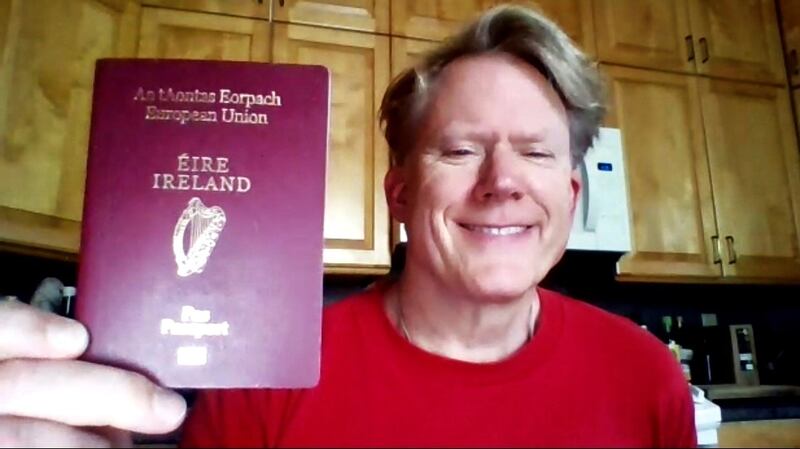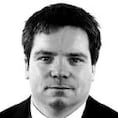Nothing illustrates the power of DNA to break through the lies and silence that surround so many family stories as in the case of John Portmann.
Mr Portmann (61), a retired American college professor, was born in Phoenix, Arizona on June 6th, 1963, into the care of the Sisters of Mercy nuns in the city. His unmarried biological mother Térese Delahanty from an Irish family in Minneapolis gave him up for adoption.
Mr Portmann knew he was adopted from an early age, but he had no idea who his biological parents were.
All that changed with a DNA test in 2019 which revealed, somewhat to his astonishment, that he was 100 per cent Irish. Three years later he was told by Department of Foreign Affairs officials in Washington that he was the first to be able to claim Irish citizenship through DNA.
The department was satisfied that he had established that his biological father Thomas Fitzgerald was from Dublin. Therefore, he was entitled to an Irish passport.
Since his story was first published in The Irish Times, his case has attracted worldwide attention with articles on CNN, the BBC and the New York Post among many outlets.
He has been contacted by others looking to follow a similar route. Mr Portmann cautioned though that the process for him was arduous and expensive involving a case to the Arizona supreme court and then an independent DNA test that cost $1,000 (€920).
“My lawyer in Arizona, the state in which I was born, was crucial to my success. The Embassy of Ireland in the USA has not only rejected my application but also told me that ‘there is no path forward for you’,” he said.
“Jay McCarthy, an adoption attorney who is himself Irish-American, gave me hope. He knew what I wanted and fought hard for it.”
Mr Portmann is especially thankful to Prof Jennifer Harris, an English professor at Canada’s University of Waterloo who responded to his request for help on Facebook.
She managed to track down his maternal family, the Delahantys to Minneapolis, relatively easily. Finding his biological father was more challenging, but the DNA match was eventually found on Ancestry.com, the American genealogy company. She checked the manifests of ships to find that not only was Thomas Fitzgerald in the United States, but he was in Minneapolis at the time of Mr Portmann’s conception.
Prof Harris’s work is driven by a belief that adoptees have historically been wronged and their rights ignored.
“I think they do have a claim; it’s part of our human desire to know who we are and what our origins are,” she told CNN.
Mark Balls (53), a British soldier based in Germany, grew up in the UK. He always knew he was adopted, but had no idea who his parents were. He took a DNA test through another genealogy company, MyHeritageDNA, and discovered that his mother Phylis O’Leary was from Co Limerick and was still alive. He has since been reunited with her and his two full brothers. His biological father died in 2012.
“Without the DNA test, I could get nowhere. I got to 1977 in Northampton and a woman with the same name as my mother. She had married a man named PJ O’Neill and I could find nothing else. Looking for an O’Neill in Ireland is like looking for a needle in a haystack,” he said.
“My advice would be not to leave it too late. I’m aware that these stories do go wrong, but you will never have the regret of having not tried.”
Genealogical scientist and television presenter Prof Turi King helped Liverpool man Richard Sayers to find his Irish father, an episode that was screened on BBC Two’s popular series DNA Family Secrets.

Mr Sayers’ mother refused to tell him who his biological father was and faked the name on the birth certificate. After she died, he did a DNA test and found out his father John*, who was from Tuam, Co Galway, had moved to Liverpool as a builder in the 1950s. Moreover, he was still alive and living in Cheshire just 40km from where Mr Sayers grew up.
The realisation has transformed Mr Sayers from an only child brought up by his grandparents to one with a father still alive, a stepmother from Limerick, three half-brothers and a half-sister.
Importantly, he was able to claim an Irish passport through DNA which came through in January. He sold his house, packed up his car and moved to Spain. As an EU citizen, he can live anywhere he wants to live in Europe., a right taken away from British citizens after Brexit.
“Otherwise I wouldn’t be able to do it. It’s been life-changing for me in so many ways. From wondering who my father was to taking all these positives from it has been some journey,” he said.
Prof King brought worldwide attention to the power of DNA by finding genetic matches to England’s King Richard III whose remains were found under a car park in Leicester in 2012. She also works on DNA Family Secrets.
“There’s some really lovely stories of people connecting and getting Irish passports off the back of DNA. but we genuinely don’t know the number,” he said.
A properly conducted DNA test doesn’t lie, she says. A DNA test will show you how much ancestry you share with another person provided that person has uploaded their DNA sample to a genetic genealogy website.
DNA matches are measured in centimorgans, a unit of genetic measurement, which accurately illustrates whether you are related to somebody and how strong that relationship is genetically.
You share about 3,500 centimorgans with each of your parents. The number of centimorgans declines with each generation of ancestry.
“It is so amazing that you find these family members that you don’t know about it. We are often in tears because we are able to put these families together,” said Prof King.
“Richard was a mess, I was a mess because he was so desperate to know who his dad was. It is an unbelievable privilege to help people find their parents.”
John Portmann carried out his successful DNA test under the supervision of the Ormond Quay Paternity Services. In a statement, Ormond Quay Paternity Services said DNA is “very accessible for everybody”.
People usually source their potential family connections elsewhere and then come to Ormond Quay Paternity Services where they will confirm or rule out the potential relationship.
“It is wonderful for people to have the opportunity to find long-lost families they did not know they had. DNA is helping many families to find their long-lost families,” the service said.
The department confirmed that it can accept DNA matches for those seeking Irish citizenship.
“Additional documentary evidence is also required before a decision to issue a passport is made,” it said.
“Such applications require considerable engagement with the applicant to ensure that the passport service is fully satisfied the applicant has demonstrated their entitlement to Irish citizenship.”
* Full name not provided
- Sign up for push alerts and have the best news, analysis and comment delivered directly to your phone
- Join The Irish Times on WhatsApp and stay up to date
- Listen to our Inside Politics podcast for the best political chat and analysis



















